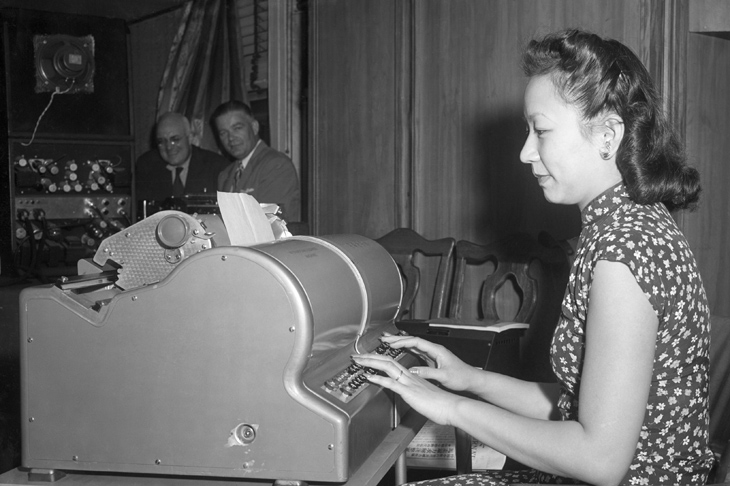The history of industry is the story of the reduction of complexity to easily manageable, replicable components or actions. But what if some things appear to remain irreducible, complex and laborious? The Chinese writing system is one such case. For early information technologists, it presented what appeared like insoluble problems. Unlike an alphabet of 26 (English) or even 84 (Siamese) letters, the huge number of Chinese ideographic characters could not easily be reduced to a typeable common corpus. (Three 20th-century compilations totalled between nearly 50,000 and over 80,000 separate characters). So while the standardised Remington-style type-writer conquered the rest of the world, China remained awkwardly to the side, leading some to lament the seeming backwardness of the Chinese character system. But others refused to be deterred, with the inventor Zhou Houkun declaring:
Blame the engineer, but do not blame the language… An engineer who cannot build machines according to reasonable specifications is not an engineer in the best sense of the word.
But statistical analyses of key Chinese texts, from Confucius to the Chinese Bible, demonstrated that perhaps a few thousand characters formed a body of common usage — radically simplifying the issue. Numerous attempts at reimagining the typewriter to handle this range were made. Zhou Houkun used a metal finding rod which would hover over a bed of 3,000 common characters (replaceable via tweezers, if less frequently used characters were required), corresponding to characters on a connected metal cylinder. When the rod was pressed down on a character on the tray, the other end brought the corresponding character on the cylinder to the printing position.
This model was bought by Commercial Press in Shanghai and became the first popular commercial machine, and indeed the subject of China’s first animated film in the 1920s. Others attempted to boil down Chinese characters into their most common components (commonly known as ‘radicals’) and have the ‘typewriters’ overlay these into coherent ideographs, almost like a dot-matrix, but these fell by the wayside, the Betamax to Zhou Houkun’s VHS.
Later models utilised some of the innovations of the Japanese during their occupation of Manchuria, though the needs of the era meant this was swiftly forgotten. The Double Pigeon typewriter that became almost as much a symbol of communist China as the Racing Pigeon bicycle had its roots in the Wanneng model (handling Chinese, Japanese, Manchu and Mongolian) which had spread under Japanese occupation. The MingKwai type-writer would finally use a traditional keyboard, but for its own purposes, its 72 keys acting as ‘switches’ to retrieve characters — 36 upper keys acting as the first level, 28 lower keys the second level, and eight numbers keys the third level, in combination giving over 8,000 possible characters. But it remained little more than a prototype.
What about computers? These use QWERTY keyboards, but in their own fashion, as characters can be corralled via several input methods. In the most common, typing in Pinyin (the Romanised version of written Chinese, which supplanted Wade-Giles), the letters ‘da’ will bring up a range of options, leading off with the most common such as (da, big) and (dă, to beat). And today, with touchscreens, input systems have come full circle, fingers tracing characters on the screen as on the sand several millennia ago.
Other technologies demanded different approaches: the telegraph system of having perhaps 40 combinations of dots and dashes represent individual characters was utterly incapable of handling Chinese. An additional layer of mediation was necessary: each Morse code referred to a number, which then referred to an individual character. But as this used around 6,800 commonly used characters, the code had to use five dots or dashes in each number (so that 10,000 combinations were available, leaving around 3,000 spaces available for individual operators to add their own characters essential for their work), making the system enormously cumbersome: the shortest ‘character’ was five dots, compared to just one dot used elsewhere, leading to codes, signs and systems, and ever greater mediation — just as emojis have become inescapable aspects of online communication.
The Chinese Typewriter: A History has a great subject, but perhaps doesn’t make the most of it. This might seem unfair: its scholarship is broad and deep, it’s mostly well organised and it conveys the struggles of those trying to drag Chinese into a more manageable condition. But Thomas S. Mullaney has a tendency to beat more out of his subject than the reader wishes; you sense him labouring to serve up every available scrap, rather than focusing on delivering the choicest cuts. You crave a lighter touch, as you find in popular academic writers such as Niall Ferguson or J.K. Galbraith. The Chinese Typewriter’s gravity of manner means it ultimately informs and illuminates, but rarely delights.






Comments